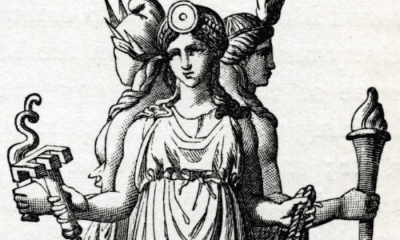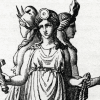Greek
What Were the Hamadryads in Greek Mythology?
Dryads are well-known nymphs in Greek legends, but what made the hamadryads different?
Dryads, or tree nymphs, appeared in several Greek legends. They remained popular in later art and literature as beautiful and mysterious nature spirits.
In Greek writing there were several types of dryads. The spirits of fruit trees, for example, were Meliades and could be found in orchards as well as in the forest.
The most unique and enigmatic tree spirits were the hamadryads. Unlike other nymphs, they were so closely tied to nature that the death of a single tree could end their lives as well.
While many of the nature deities of Greek mythology likely have ties to more ancient religious traditions, the hamadryads represent a view of the natural world that might have been one of the oldest beliefs in Europe.
The Hamadryads and Their Trees
The dryads were tree nymphs in ancient Greek mythology. Like other nymphs, they were feminine spirits of nature.
They were said to be exceptionally shy, with many only ever revealing themselves to Artemis. It was therefore impossible for a human to know whether a dryad was nearby or not.
Many types of dryads moved through the forest and could hide if needed. These tree nymphs were spirits of the forest in general or of a specific type of tree within it.
Some, however, were tied to an individual tree. These were the hamadryads.
The two terms were often used interchangeably in Greek writing, but specific beliefs existed regarding the Hamadryads.
They were most often linked to oak or poplar trees. And, unlike other nymphs, their lives were tied to the fate of a specific tree.
As minor deities, the dryads were all long-lived. The hamadryads were unique as one of the few types of divine beings who could be easily and routinely killed by the actions of mortals.
Because they were connected to a specific tree rather than a forest or type of tree, if their tree was destroyed they would be as well. Cutting down or otherwise killing a tree would end the life of the hamadryad that lived within it.
Because the hamadryads were so vulnerable, the gods were protective of the trees in which they lived. Humans who cut down or damaged one of these trees could be met with harsh punishments for killing a dryad, even accidentally.
To prevent this, Greek loggers typically offered sacrifices to the tree nymphs before and after they worked. By giving propitiations, or offerings to the dead, they hoped to pacify the gods and the spirits of any dryads they may have harmed.
Still, Greek people knew to take care when working in the forest. In addition to the dangers posed by the physical world around them, they were also aware of the danger of harming one of the nymphs that had the protection of the gods.
When care was taken for these nymphs, however, men could be rewarded.
Although they were tied to specific trees, and were believed by some to be the tree itself, many hamadryads became mothers. One, for example, fell in love with a woodsman who saved her tree from being destroyed in a flood.
My Modern Interpretation
The nature gods of mythology, including the hamadryads, likely represented some of the most ancient traditions of the Greek people.
Early religions generally did not have complex mythologies and human-like gods and goddesses. Instead, they were based on the forces of nature and the visible world.
This is still evident in many religions today. In Japanese folklore, for example, the world is filled with kami who are often spirits of nature or elements rather than powerful gods.
The nymphs and rustic gods of Greek mythology are believed by many historians to be relics of older animistic religions. Before the Greek people worshipped powerful Olympian gods with phenomenal powers and complex stories, they believed that the world around them was filled with nature spirits that could influence their lives.
While minor deities like the river gods and oreads, or mountain nymphs, were remnants of these ancient beliefs, the hamadryads may have been the most direct way in which these older religious traditions survived in Classical Greece.
The idea of sacred trees and groves was a widespread one in ancient Europe. Archaeologists have found evidence of trees holding a central place in religion from prehistoric times.
Sacred trees continued into recorded history. They are well-attested in later accounts of Germanic and Celtic culture and are mentioned in Christian stories that describe the conversion of Europe’s pagans.
The Greeks centered their religion around man made temples rather than sacred trees, but some natural sites were still important in their religion.
Several temples had sacred groves. These are included in several myths, such as the grove of Ares where the golden fleece was kept in the Argonautica.
Such groves were also said to be the home of the hamadryads. Although sacred trees were no longer central to Greek worship, their memory was preserved in these spaces.
Hamadryads could also exist in the wild, however. This detail in their legends is further evidence that they were likely relics from a time before the Olympian pantheon.
The dryads, specifically the Hamadryads, were most closely associated with oak and poplar trees. These were the trees that were often found near springs and rivers, as well as closest to human settlements.
The stories of hamadryads being found in the trees along streams preserved the memory of the sacred trees of pre-Greek culture. The Greeks did not know which trees may have been sacred, meaning which housed a dryad, so they took precautions in assuming that any tree could have been tied to the life of a nymph.
In Summary
Greek mythology specified several different types of nymphs. The ocean, streams, and the mountains were each home to a different group of minor goddesses.
One type were the dryads, or tree spirits. They, too, consisted of different groups that usually corresponded to different types of trees.
The hamadryads were a specific type of nature goddess that was usually associated with oak or poplar trees. Unlike other nymphs, their lives were directly tied to the trees they called home.
If a hamadryad’s tree was cut down or killed in another way, the dryad herself would die within it. Because of this, the gods were known to be protective of sacred groves and often punished those who cut down hamadryads’ trees.
Greek people were careful not to cut down any trees that may have been tied to the hamadryads, who were so secretive that there was no way of knowing where they lived. When trees had to be cut, offerings were made to appease both the gods and the spirits of any dryads that may have been killed in the process.
The hamadryads were probably relics of an older religious tradition in Europe. The belief in sacred trees was one of the oldest and longest-lasting in many cultures.
While the Greeks built monumental temples and erected man made shrines, sacred trees and groves still played an important part in their religion and mythology. The hamadryads were part of a not-entirely forgotten tradition that saw the natural world as a sacred place.



